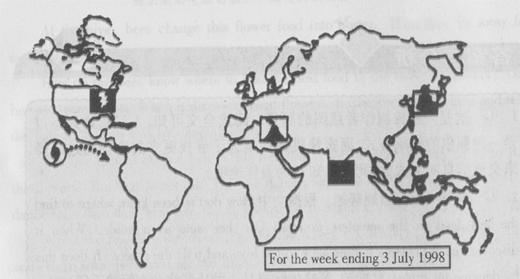题目内容
A severe heatwave sweeping India, with temperatures of almost 44??C, the highest in 52 years, has killed at least 80 people this month, officials said on Sunday. The hot weather, which officials say would continue over northern, north-western and central India in the next 48 hours, also may have some impact on wheat production, exporters and flour-mill associations said.
New Delhi recorded a maximum temperature of 43.7??C on Saturday, indicating a hot summer in the next two months in the nation's capital and other parts of northern and eastern India. The highest temperature in the past 24 hours was 47??C at Ganganagar city, in Rajasthan state. Summer temperatures have been 4??C-6??C above normal over most parts of northern and central India since March, weather officials said.
In the eastern state of Orissa, authorities have decided to shut down schools from next Tuesday, advancing the annual summer holiday. Authorities said they were investigating reports of 53 deaths from various parts of the state.
"District collectors have been asked to investigate and submit reports on other deaths," Bhimsen Gochhayat, a government official said. Other deaths were reported from northern state of Uttar Pradesh and central Madhya Pradesh states.
India is expected to produce about 82 million tons of wheat in 2009-2010, but there could be a shortage of 1-1.5 million tons due to the heatwave, said Veena Sharma, Secretary General of the Roller Flour Millers Federation of India. "Most of the harvesting is over, but there definitely will be a slight shortage o![]() f 1-1.5 million tons due to the extreme weather conditions," she told Reuters.
f 1-1.5 million tons due to the extreme weather conditions," she told Reuters.
India is relying on an abundant wheat crop to make up for a 14.2% drop in rice output, the major summer-sown food grain, marred by the worst monsoon (季风)in 37 years last year. Weather officials say with summer temperatures in India set to remain above average, there were hopes of heavy rains at the start of the monsoon season that will help early sowing of rice, soybeans and lentils.
The purpose of the passage is ____________.
A. to tell a piece of news of a heatwave B. to record the highest temperature in India
C. to report the deaths in the heatwave D. to inform people of a drop of rice output
Which of the following is TRUE according to the passage?
A. The hi![]() ghest temperature in the history of India was 44??C.
ghest temperature in the history of India was 44??C.
B. Schools were closed because of the hot weather throughout India.
C. India is expected to produce about 82 million tons of rice in 2009-2010.
D. India has a good harvest of wheat while the rice output is decreasing.
The underlined word “marred” in the last paragraph probably means “___________”.
A. reduced B. damaged C. blown D. followed
What is the main idea of the passage?
A. A severe heatwave would continue over India.
B. At least 80% people were killed in the disaster this month.
C. A severe heatwave swept India with a great loss.
D. A slight shortage of 1-1.5 million tons is due to the heatwave.
【小题1】A【小题1】D【小题1】B【小题1】C
解析:
略

ERATH WEEK---A DIARY OF THE PLANET
Enduring Storms
Several more rounds of severe storms, tornadoes and flash flooding struck many parts of the American Midwest and Northeast as bad weather continued across the US for a second month. 
Monsoon Storms
A south-west monsoon has caused havoc in parts of Sri Lanka. Government meteorologists said that unexpected monsoonal winds blew directly across the country from the Southern Hemisphere at about 100km/h, p roducing several rounds of stormy weather. Nearly 250 houses in the capital Colombo were damaged.
roducing several rounds of stormy weather. Nearly 250 houses in the capital Colombo were damaged.
Mt. Etna Erupts
Sicily’s Mount Etna volcano erupted shortly after midnight on July 1, shooting “bombs” of lava nearly 1.5 meters in diameter on the eastern side of the mountain. The 30-minute eruption could be seen for several miles, but did not threaten any nearby villages.
Hurricane
Hurricane Blas lost strength as it moved over cooler waters in the Pacific Ocean to the west of Mexico. Blas formed off southwest Mexico during the previous week, but squalls on the outer fringes of the storm lashed western Michoacan State, killing four people when their wood and cardboard home collapsed.
Monkey Repellent
After years of unsuccessful attempts to keep crop-eating monkeys out of Japanese fields, a Tokyo research team believes that it may have finally found a way to prevent the damage caused by the monkeys. Animal raids on crops were successfully prevented by shooting chilli powder into the air, irritating the e yes and noses of monkeys that passed in front of carefully-placed warning sensors. “We’ve tried al kinds of preventive measures, but the monkeys are smart enough t
yes and noses of monkeys that passed in front of carefully-placed warning sensors. “We’ve tried al kinds of preventive measures, but the monkeys are smart enough t o outwit the tricks, “said Toshiaki Wada, Director of the Tokyo Forestry Experiment Station in western Tokyo.
o outwit the tricks, “said Toshiaki Wada, Director of the Tokyo Forestry Experiment Station in western Tokyo.
【小题1】.
. According to the information, which of the following statements is TURE?
A. The eruption of Mt. Etna lasted thirty days.
B. Hurricane Blas was formed off the coast of Italy.
C. The American Midwest had fine weather throughout July 1998.
The eruption of Mt. Etna did not destroy local villages.
【小题2】.
. According to the information, the monkeys in the Japanese fields ________.
| A.destroy crops | B.kill unsuspecting humans |
| C.spread eye diseases to humans | D.stop farmers from working |
. The information in the “Earth Week” diary _______.
| A.predicts future weather patterns |
| B.gives advice on dealing with monsoons |
| C.shows that weather can be unpredictable |
| D.shows the effects that storms have on animals |

